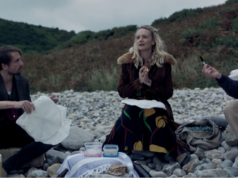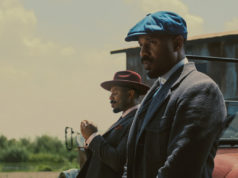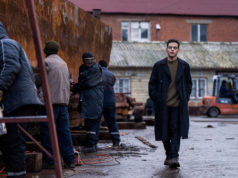Sometimes your work and your passions collide. In other words, I’m getting paid to write about a Godzilla movie. Thankfully, Shin Godzilla is pretty damn good. Too bad, for once, I’m not crazy about Godzilla himself. Or itself. But I’ll get to that.
To explain the title, “shin” in Japanese means many things, including “new,” “true,” and “god.” The last meaning is the one that’s most important, as “god” isn’t just invoked when Godzilla is named, but the power on display is akin to that of an angry one. “New” applies as well, not only because this is the first Toho Godzilla movie since 2004’s Godzilla: Final Wars, but because this is the first time a Godzilla film is unconnected to the 1954 original. So when the Big G comes out of Tokyo Bay, it’s the first time anyone, anywhere has seen a giant monster.
This puts the government in a tizzy, and it’s the reaction from the cogs which forms the focus of the movie. And that focus is: bureaucracy. Low-level Deputy Chief Cabinet Secretary Rando Yaguchi (Hiroki Hasegawa) leads a group of loners, radicals, and like minds to find a way to take down the monster and navigate the rules and laws governing every little action to do so. About 70 percent of the film takes place in offices and boardrooms, but this makes the film compelling, with dynamic camera work, attention to detail, and a wry Japanese sense of humor at the jumbled governmental process. There’s also a theme of people coming together to solve a problem, evoked in everything from the banal lighting of the typical offices where the world-saving work is done to a creative use of the Tokyo train system at the end. What gives this added punch is how much it comments on the Japanese government’s reaction to the 2011 Fukushima Plant disaster, which has as much impact here as the bombings of Hiroshima and Nagasaki did on the original, down to a speech given by Yaguchi to those who will be risking their lives to stop Godzilla that practically, and stirringly, salutes the Fukushima 50.
The cast members help sell both the dry humor and the earnestness of the story, though as a non-Japanese speaker I had difficulty gauging the performances. Hasegawa is lively and driven as Yaguchi, a man trying to untangle the red tape hampering him from dealing with the beast. Entertaining supporting players, particularly Mikako Ichikawa’s stern and blunt scientist Hiromi, keep the audience invested and the spotlight on how everyone plays a part in defeating Godzilla. The only weak spot is Satomi Ishihara’s Kayoko Patterson, a supposed half-American who is fine except for her English-language scenes that don’t fool anyone except maybe people who don’t speak English.
Also new is the approach to Godzilla. Writer/Director Hideaki Anno, best known for introducing extreme weirdness and clinical depression to the mecha genre with his groundbreaking anime Neon Genesis Evangelion, brings that weirdness not just to focusing on bureaucracy but to Godzilla itself. It first slithers out of the ocean googly-eyed, with no arms, looking like a giant Kermit the Frog that’s been in a fire. Then it evolves arms and stands upright, and that’s just in its first appearance. In fact, the one interpretation of “shin” I take issue with is “true.” Iconic roar and theme music or no, Anno’s monster, with its altered nature and powers, feels less like Godzilla and more like, without giving too much away, one of his previous, more destructive foes. Combine that with occasionally stiff CGI and puppetry and a gruesome, expressionless design, and I didn’t get the thrill that I usually get seeing Big G in action.
But this also gives the film more in common with the first movie in another way: the monster not as character but as symbolism. And not only are the action scenes thrilling, but the trashing Godzilla gives Tokyo is among the most devastating yet. Like the greatest cultural icons, Godzilla endures because he evolves. He’s gone from a somber symbol of nuclear destruction to kid-friendly hero and back. So if you, like me, didn’t care much for Anno’s G, just wait for a sequel to the American movie or the upcoming 2017 anime film. And even then, considering how this movie ends, I would still like to see where this unique take goes.
Fanboy complaints aside, Shin Godzilla is a success, blending bureaucratic detail with monstrous mayhem into one exciting package, with enough nods to the original and more than enough originality to let it stand and destroy Tokyo on its own.
[box_info]Shin Godzilla
Starring Hiroki Hasegawa, Satomi Ishihara, Yutaka Takenouchi, and Mikako Ichikawa. Directed by Hideaki Anno and Shinji Higuchi. Written by Hideaki Anno. Not rated (PG equivalent).[/box_info]












